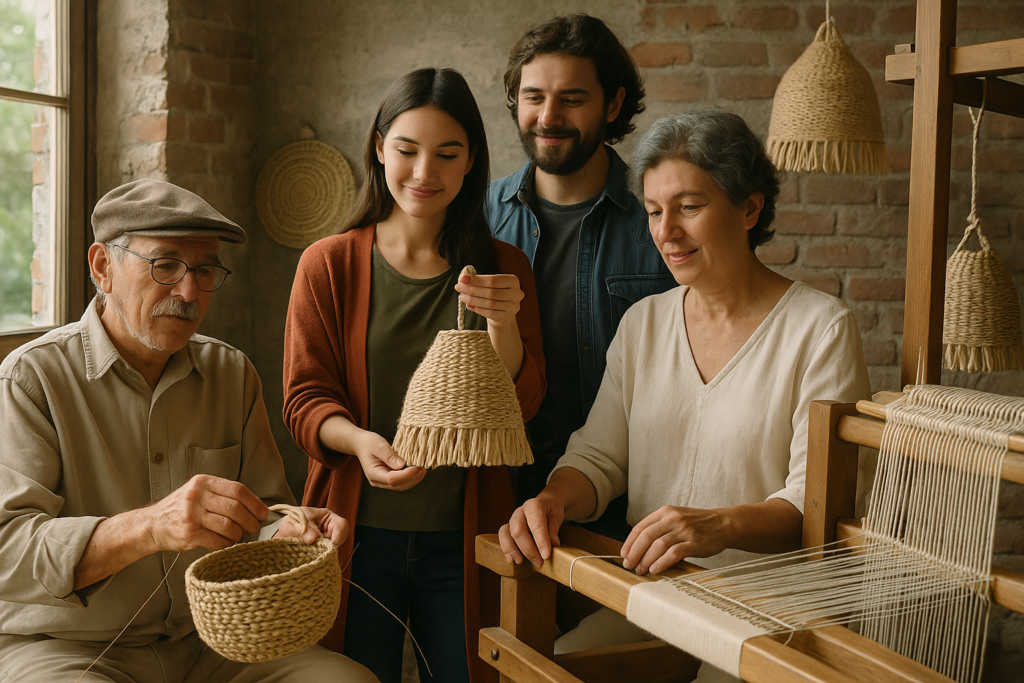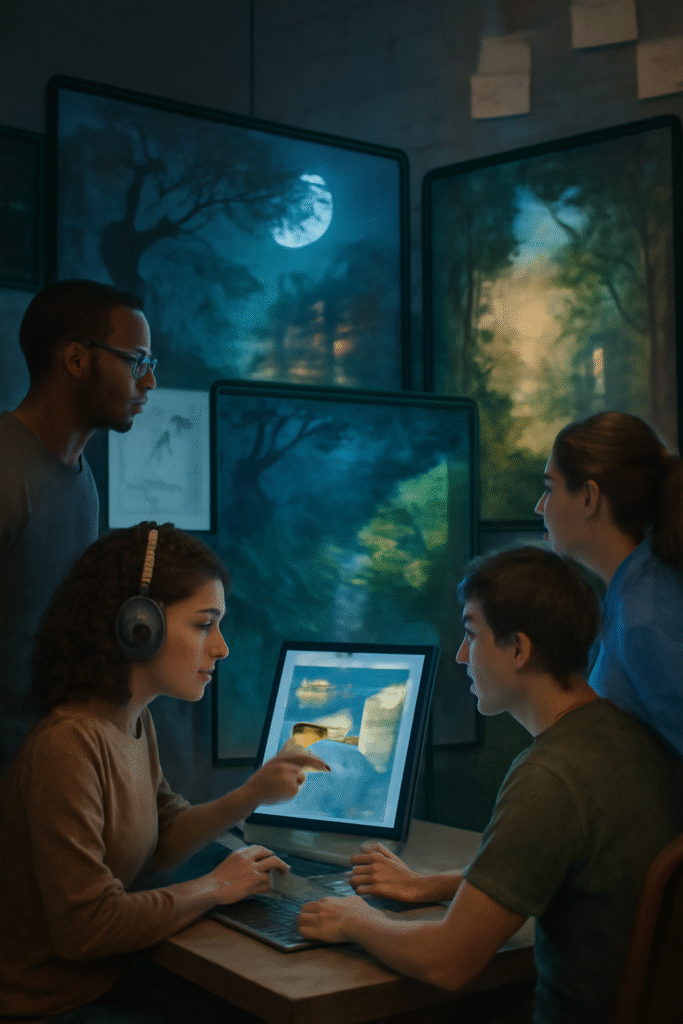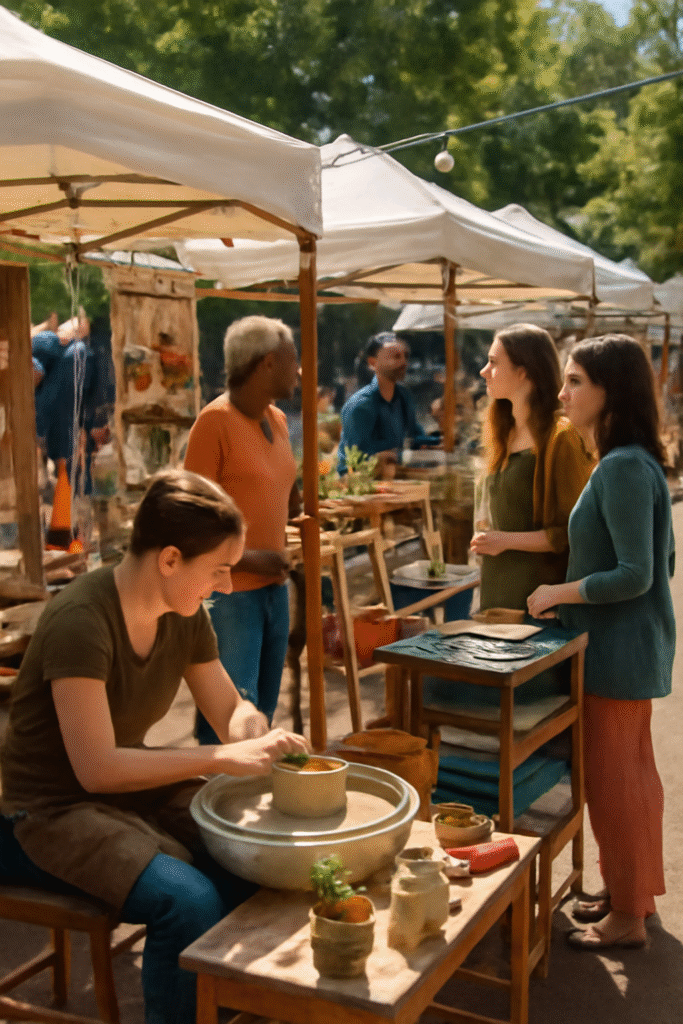Como pessoas — de pequenos vilarejos a coletivos virtuais — continuam reinventando o significado de cultura.
A cultura vive e respira através das pessoas.
Ela não é uma relíquia congelada no tempo, mas um movimento constante — moldado diariamente pela imaginação, pelo fazer e pela conexão.
Cada tradição, cada projeto compartilhado, cada gesto criativo renova esse fio vivo que nos une.
Embora a globalização muitas vezes empurre a sociedade para a homogeneidade, as formas mais originais de cultura ainda surgem localmente — em bairros, cooperativas rurais e grupos online unidos por paixões comuns.
Essas comunidades continuam provando que a criatividade se expande pela colaboração, que a inovação pode ser ao mesmo tempo, enraizada no passado e aberta ao futuro.
O que as inspira a ir além do esperado?
Geralmente, a faísca nasce do compromisso coletivo: uma mistura de orgulho, curiosidade e do desejo de fazer o patrimônio dialogar com novas gerações.
Vamos explorar algumas histórias que revelam o poder da imaginação coletiva.
Ancorados nas Raízes: Quando o Patrimônio Desperta a Inovação
Alguns dos movimentos culturais mais visionários vêm de pessoas que olham para trás primeiro.
Comunidades que enfrentam o desaparecimento de seus ofícios ancestrais muitas vezes respondem não preservando a tradição como uma peça de museu, mas transformando-a.
Estudo de Caso 1 — “Fios do Amanhã”: Reinventando o Artesanato para a Vida Moderna

Em uma pequena cidade do interior, a cestaria e o trabalho em tear já definiram a vida cotidiana.
Com o tempo, as gerações mais jovens se afastaram, e o ofício parecia destinado a desaparecer.
Então, um grupo de artesãos veteranos uniu forças com jovens designers locais que estavam retornando da cidade.
Juntos, criaram o “Fios do Amanhã”.
Em vez de reproduzir o que veio antes, eles reinventaram.
Descobriram novas fibras naturais que cresciam na região, combinaram métodos tradicionais com designs experimentais e transformaram o ofício em objetos de arte contemporânea — peças vestíveis, luminárias e itens de decoração.
Por meio de narrativas digitais, eles compartilharam não apenas as obras finalizadas, mas também as pessoas e paisagens por trás delas.
As redes sociais atraíram atenção, turistas visitaram seus ateliês e até artistas urbanos se juntaram para aprender suas técnicas.
O resultado não foi nostalgia — foi renovação.
A tradição da tecelagem tornou-se um negócio sustentável e um forte emblema de identidade.
A lição: quando idosos e jovens colaboram, a inovação nasce naturalmente do diálogo entre gerações.
Mundos Digitais, Imaginação Compartilhada: Cultura Além das Fronteiras
A internet expandiu o significado de “comunidade”.
Pessoas que nunca se encontram pessoalmente ainda podem criar lado a lado, combinando ideias que transcendem idioma, disciplina e geografia
Estudo de Caso 2 — “Os Tecelões de Histórias Online”: Cultura Interativa para a Era da Conexão em Rede

Dentro de um centro virtual de artistas e programadores, surgiu uma coalizão conhecida como “The Story Weavers Online”.
Eles não estavam interessados em romances estáticos ou narrativas lineares.
Queriam criar experiências interativas — espaços onde arte, música, escrita e programação se misturam.
Imagine abrir uma história em que você navega por escolhas, explora mundos ilustrados e ouve músicas que mudam conforme suas ações.
Cada criação resulta do trabalho conjunto de escritores, ilustradores, músicos e desenvolvedores — todos colaborando remotamente por meio de plataformas digitais.
Essa comunidade usa ferramentas de código aberto e inteligência artificial não para substituir a criatividade, mas para ampliá-la.
Eles geram personagens adaptáveis, desenham ramificações narrativas que reagem às decisões dos leitores e experimentam com realidade aumentada para misturar ficção com o ambiente físico.
A pergunta deles não é “Como contamos histórias?”, mas sim “Como podemos viver dentro delas?”
O resultado não é um livro nem um jogo — é uma invenção cultural compartilhada, um vislumbre de como pode ser a narrativa no século digital.
O Movimento Híbrido: Onde o Físico e o Digital se Encontram
Algumas comunidades descobriram inovação justamente nesse cruzamento de espaços.
Perceberam que a tecnologia poderia fortalecer a conexão no mundo real em vez de substituí-la por completo.
Estudo de Caso 3 — “The Living Exchange”: O Mercado que Nunca Dorme

Em uma grande cidade, um grupo de artistas independentes, produtores de alimentos orgânicos e artesãos buscava uma forma de sobreviver em uma economia acelerada sem perder seu senso de propósito
Eles iniciaram uma feira mensal ao ar livre, chamada “The Living Exchange”.
Logo perceberam que um único fim de semana não era suficiente para sustentar sua rede.
Então ampliaram o mercado para o ambiente digital — não apenas uma loja online, mas uma plataforma viva.
Artesãos compartilhavam histórias sobre seus materiais, transmitiam oficinas e colaboravam entre si por meio do estúdio virtual do site.
Um blog publicava entrevistas e vídeos que aproximavam criadores e públicos que não podiam estar presentes fisicamente na feira.
O modelo funcionou porque combinava experiência sensorial com visibilidade constante: interação real no espaço físico e participação global no digital.
A feira preservava o calor humano; a plataforma mantinha o ritmo.
Juntas, criaram um ecossistema autossustentável que celebrava artesanato, comunidade e consumo ético.
O Que Essas Narrativas Revelam Sobre a Cultura
Cada uma dessas comunidades ensina algo essencial sobre o pulso criativo do nosso tempo:
A cultura sobrevive pelo movimento. Ela não desaparece — se adapta e se transforma quando tocada por uma nova curiosidade.
A inovação é relacional. A colaboração carrega mais força do que qualquer gênio isolado.
A tecnologia só é significativa quando empodera pessoas. Ferramentas digitais ampliam a autenticidade; devem servir, não ofuscar, a história humana.
A conexão real começa com sinceridade. O público responde não à perfeição, mas a projetos enraizados em identidade genuína.
Cultura como Horizonte Compartilhado
Comunidades inovadoras não são exceções — são sinais do rumo que a cultura está tomando.
Elas desfazem fronteiras entre artesão e designer, programador e contador de histórias, local e global.
Mostram que progresso não significa abandonar o patrimônio, mas fazê-lo falar uma nova linguagem.
Do artesanato revitalizado, à ficção participativa e aos espaços criativos híbridos, esses movimentos nos lembram que cultura é um verbo — algo que fazemos, construímos e compartilhamos.
Sua imaginação coletiva ganha forma.
E assim, permanece a pergunta:
Que tipo de cultura nós criamos todos os dias, por meio de nossas escolhas, colaborações e paixões?
Talvez a resposta não esteja na inovação em si, mas na coragem de imaginar juntos.
